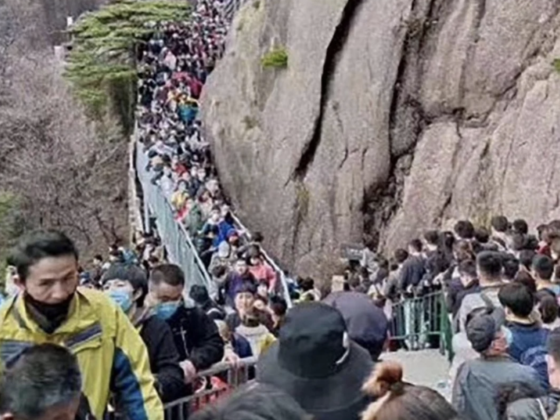Reopening society after months of lockdown is a careful balancing act. People are understandably eager to leave their homes and enjoy freedoms previously denied to them, but unless governments are careful, there is a high risk that coronavirus will return for a second wave. China, the first country to be hit by the virus and also the first to impose strict lockdown measures, has been gradually reopening its country over the past week, so it’s no surprise that people are leaping at the chance to take advantage of their newfound freedoms. The volume of visitors at some popular attractions, however, is raising concerns that “normal life” might be resuming too fast.


China Is Gradually Reopening After a Months-Long Lockdown, but It’s Already Raising Major Safety Concerns
Photographs have emerged of massive crowds at the Huangshan Mountains in Anhui province, and not everyone is taking it as a sign of encouragement. On the one hand, the crowds are a good indication that people are more than willing to travel, congregate, and enjoy life post-coronavirus, and that the months-long lockdown hasn’t stoked a crippling agoraphobia. On the other hand, the large crowds are prompting concerns and questions that China lifted their lockdown too early and that tourist sites aren’t equipped to properly manage bottlenecks.
Health precautions are being taken, however. At the Huangshan Mountains and other sites, visitors are being asked to show their health status on an app, wear surgical masks, and have their body temperatures taken before being allowed entry. Parks like the Huangshan Mountains have also been dramatically reducing their maximum capacity by as much as 60 percent, meaning photos of seemingly out-of-control crowds may just be the result of poor crowd management rather than a representation of overwhelming visitor numbers.
Benjamin Cowling, professor of epidemiology and biostatistics at Hong Kong University, told CBS News, “I think China is keeping a close eye on COVID-19 detections and may need to tune the social distancing measures that are needed to keep COVID-19 contained. For now, it may be OK to relax some measures, but those measures should be tightened if case numbers pick up.”
In Wuhan, where the lockdown lasted 11 weeks, restrictions are slowly being relaxed after a sustained decline in new infections. Starting Wednesday, outbound travel bans were lifted, and airports and train stations reopened. Much like a city transitioning from war to peacetime, Wuhan celebrated by illuminating bridges and skyscrapers with inspiring messages, and people gathered by the river to sing the Chinese national anthem. Expecting anything less from this harrowed city would be unreasonable, and it is an inspiring sight to behold — especially for other countries that are further behind and still under strict lockdowns.
Epicenter W U H A N Now 💐
Lock Down Over 🤘🏕
Expecting other Countries to be Soon 😐💐 #CoronaOutbreak #Wuhanlockdown pic.twitter.com/rT1IdEvmci
— Dr.Bohra 2.0🤘🌟 (@Puvi_0309) April 8, 2020
Some restrictions are still in place — residents must use a smartphone app to certify their health status. But there are underlying fears of the virus’s resurgence and the continued need for regular lockdowns.
According to Cowling, “One of my concerns is that we’re going to get into a nasty cycle of having to have repeated lockdowns maybe every two or three months because there will be a resurgence in infections.”
Professor Joseph T Wu from the University of Hong Kong echoed this cautious outlook. He told CNN, “Cases could easily resurge as businesses, factory operations, and schools gradually resume and increase social mixing, particularly given the increasing risk of imported cases from overseas as COVID-19 continues to spread globally. Although control policies such as physical distancing and behavioral change are likely to be maintained for some time, proactively striking a balance between resuming economic activities and keeping the reproductive number below one is likely to be the best strategy until effective vaccines become widely available.”
No one can predict when easing the restrictions will be 100 percent safe, but governments around the world are trying to strike a delicate balance between safety and a return to economic and social familiarity. Citing the peak and subsequent reduction in cases, many European nations have set tentative April and May dates for the reopening of small businesses, schools, and other services. This is good news not only for Europeans but for anyone looking for a hopeful sign that the lockdowns won’t, in fact, last forever. But just like China, there are concerns these optimistic returns to relative normalcy are coming too soon.
Cases may surge once lockdowns are lifted — as experts have warned — or they may not. It likely depends on governments heeding the advice of health officials, slowly and cautiously relaxing social distancing, keeping an eye on the numbers, and taking precautionary health measures even after life returns to normal. In any case, avoiding crowds and major tourist attractions for the foreseeable future is probably still the best practice, and if your lockdown lifts, it’s still best to stick close to home.